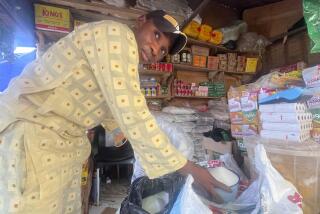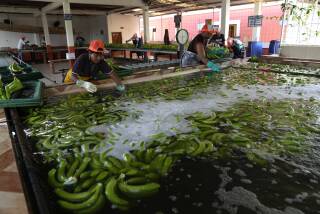In Guyana, Sugar Cane Remains King and Cutting It Anything but Sweet : South America: The country remains as tied to sugar for foreign exchange as the cutters are for earning a living. Most of it goes to Britain as part of guaranteed annual sale to European Union.
- Share via
LA BONNE INTENTION, Guyana — Any legitimate history of the Caribbean Basin must focus on the centuries of bitter labor in cane fields that have fed the passion for sweets in Europe, Asia and North America.
The demand for sugar caused the Dutch to build dikes and canals here in the seaside lowlands of northeastern South America. It prompted their British successors to import African slaves and indentured workers from India to till the soil and, like their descendants today, stoop and strain to cut the thick, tough stalks.
Guyana’s plantations are state-owned now, but because of mismanagement, supervision has been returned to Booker-Tate, the British company that once owned them. After decades of independence, Guyana remains as tied to sugar for foreign exchange as do the cutters for a living.
“Sugar is still the backbone of this economy. Without it, Guyana is nothing,” said Dean Ali, 56, who supervises 600 workers on La Bonne Intention, a 23,000-acre estate seven miles east of Georgetown, the capital. Ali grew up in the sugar fields and became a manager with Booker-Tate in 1976.
Life on a cane plantation has been much the same for generations.
Cutters line up at the entrance before dawn, equipped with machetes and lunch bags of curried meat and rice. The supervisors stroll in from their comfortable houses, past the tennis courts built for them and their children.
Workers crowd into the open backs of trucks that carry them to the fields, often miles away over bumpy trails that run along the canals.
There are snakes and fierce Africanized honeybees in the fields some days, and caimans emerge from the canals. The sun gets so hot that much of the best work is done before 9 a.m. Without missing a beat as they chop row after row, the men talk of making it north to better lives in the United States.
At the end of the day, they pile the cut stalks next to the canals. Other men load the cane onto pontoon boats and tractors pull the boats to the mill a dozen at a time.
Among those at the gate one morning was Mooklall Ramuth, dirty-faced, wearing a yellow-and-red shirt, blue pants and dusty shoes. He and the others cut and clear the fields for the equivalent of about 25 cents an hour.
“I’m always just thinking about finishing the cane,” Ramuth said, sharpening his machete. “Every day, I feel very tired. Cutting work is very hard.”
Ramuth started cutting at age 15. He is 49 now.
Although their work is different, the bosses share Ramuth’s obsession: “With sugar, you live it, you sleep it,” said George Allen, an administrator at La Bonne Intention. “You’re always thinking about it.”
Most of the sugar goes to Britain as part of the 167,000-ton guaranteed annual sale to the European Union.
Ali said Booker-Tate had improved the lot of workers over the years, stopping the use of child labor and providing canvas bags of water so cutters do not have to drink from the canals.
But the drudgery remains. As a chicken hawk flew overhead, Ali watched the laborers from the back of a truck, chewing on a piece of cane.
“Cane cutting is the toughest job,” he said.
In “Sugar Cane,” Trinidadian poet Faustin Charles says of the labor of cutting:
Cane is sweet sweat slain;
Cane is labor, unrecognized, lost
And unrecovered;
Sugar is the sweet swollen pain of the years;
Sugar is slavery’s immovable stain;
Cane is water lying down,
And water standing up.
Cane is a slaver,
Cane is bitter,
Very bitter
In the sweet blood of life.
More to Read
Sign up for Essential California
The most important California stories and recommendations in your inbox every morning.
You may occasionally receive promotional content from the Los Angeles Times.













